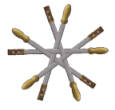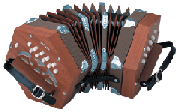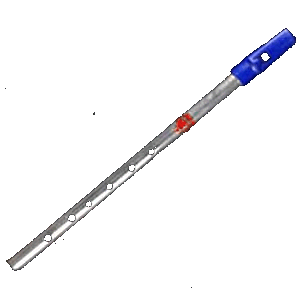 |
 |
 |
|
||
 |
 |
 |
|
||
Musicians and Instruments
| Only one Musician
is used to accompany a rapper sword dance. Traditionally,
this instrument was usually the Fiddle
or the English Concertina, although in
one village tradition (Winlaton) the musician apparently
played a Tin Whistle. Since those times, other instruments have also been used, such as the Anglo Concertina and the Melodeon. These instruments naturally lend themselves more to the style of music needed for Cotswold Morris, rather than to rapper sword, but nevertheless can still be employed to great effect in the hands of a skilled musicians, as evidenced with the melodeons used in Bristol Rapper. Today, the factor determining the actual instrument used is often the availability of a musician who can play the jig tunes with the required style, timing, and speed, rather than any strict adherence to original tradition. If the music is especially well played, the dancers will automatically respond by dancing more accurately and enthusiastically. Generally speaking, if the dancers think that the music's right, it will be! Bristol Rapper has the benefit of several musicians, all of whom are busy people, so they take it in turns to play for us when we are out on tour. The instruments used by our current rapper musicians are the Fiddle and the Melodeon. |
|
Fiddle This is of course the same instrument as the violin, except that the playing style is vastly different. The way that the instrument and bow are held often differs from that of the classical musician, and playing is usually done "by ear", rather than from music. Working on the basic melody, a fiddler will often add ornamentation in the form of grace notes, or apply harmony using a technique known as "double stopping". The tuning of a violin (G, D, A & E) offers more opportunities for open-string playing in the keys of G, D and A, so a fiddler often uses these keys - or their relative minor or modal equivalents. |
|
Melodeon This is one of the family of free-reed instruments, where the sound is produced by the passage of air across a metal reed - fixed at one end. It is often confused by the general public with the Accordion, from which it differs in two major respects. Firstly, the melodeon is a single-action instrument with tuning similar to that of a harmonica - a push or pull of the bellows gives a different note. Secondly - unlike the accordion - the melodeon is not chromatic. The number of major keys available is determined by the number of rows of keys for the right hand - two in the illustration. The two-row melodeon preferred by the traditional musician is G-D, (the three-row choice being G-D-A). In either case, a simple bass accompaniment is available by using the keys available to the left hand. |
| In past years, Bristol Rapper musicians have used both the English Concertina and to a lesser extent, the Anglo Concertina: |
|
English Concertina The concertina (also a free-reed instrument) was invented in 1829 by the physicist Charles Wheatstone (of Wheatstone Bridge fame). As a scientist, he concluded that a theoretical maximum efficiency of the bellows would be achieved if the bellows were cylindrical. As it was not possible to manufacture cylindrical bellows, he compromised with an octagonal shape. This did however prove to be expensive, so later models were hexagonal. He also designed the key mechanism and the playing system. There are 48 keys (24 at each end) giving a range of four octaves (the same as the violin). The instrument is double-action i.e. a push or pull of the bellows gives the same note) and - unlike the melodeon - it is chromatic (i.e. you can play in any key). As both sides are needed to play the melody, there are no bass keys, though simple treble harmonies are possible by simultaneously pressing more than one button. |
 |
Anglo Concertina The English Concertina was first marketed in 1836, and soon became very popular - its UK sales displacing that of the melodeon, (mainly imported from Germany at that time). Not to be outdone, the German manufacturers came up with a hybrid instrument - the German Concertina. This used Wheatstone's shape, but with a single-action playing system similar to that used on the melodeon. The British manufacturers quickly retaliated by copying the idea: hence, the Anglo-German Concertina - later shortened to Anglo Concertina. The playing capability of this instrument is similar to that of the melodeon, but with a smaller pitch-range. It does however offer the advantage of greater portability. As with the melodeon, two and three-row versions were (and still are) made, C-G being the most common. G-D or G-D-A combinations are probably the most suitable for traditional playing, but these are somewhat rare, and therefore sought after. |
 |
Tin Whistle The Tin Whistle (also called the Penny Whistle) is a wind instrument of the Fipple Flute family. The sound is produced by blowing air against a sharp edge within the mouthpiece called the Fipple. This instrument, though originally tinplate, is now made from a variety of materials including wood, plastic, various alloys, and plated steel. Tin whistles are available in various sizes (and therefore, Keys), the keynote or Fundamental being the note obtained by covering all six holes and blowing with moderate pressure. Progression up the first octave is achieved by progressively lifting fingers (starting furthest from the mouthpiece) until all the holes are uncovered. The eighth note of the scale is then achieved by covering all of the holes again, and repeating the process, but while blowing with increased pressure (overblowing). This process can indeed by continued some way into the third octave, but with increasing difficulty. Surprisingly, it is not always necessary to swap whistles in order to change key. Although the whistle is essentially a diatonic instrument, semitones can be achieved by Cross-Fingering (alternative fingering) or Half-Holing (partially covering a hole). A popular choice for the folk musician is the D-Whistle, as it may be used for the three "folk" keys: G, D and A. Tunes in D can of course be played using the standard fingering. Tunes in the key of G can be played by using cross-fingering to obtain C-Natural, and tunes in A can be played using half-holing to produce G-Sharp. |
![]()